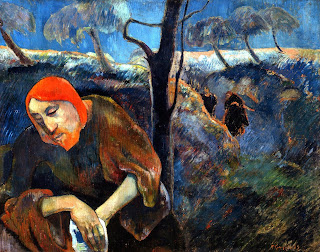 |
| School of Veronese. Portrait of Sultan Bayezid I. c.1580. © Islamic Arts Museum Malaysia |
Western artists have long been intrigued by the Islamic
world. This sweeping new exhibition at the British Museum covers more than five centuries of artistic
interaction, beginning with portraits such as this depiction of a Sultan and continuing through the tradition known
as Orientalism to the present day. The earliest European interest in the Middle
East was religious, focusing on pilgrimages to places mentioned in the Bible.
Jerusalem was the most important, and was shown in great detail on a
pull-out map in a book dating from 1486 that recounts the visit of a German knight
to Palestine and Egypt. Diplomats established embassies, and there was much
interest on both sides. One, in the Austrian
service, wrote in 1581: “The Turks were
quite as much astonished by our manner of dress as we at theirs.” Their
presence provided work for both European and local artists, keen to portray the
exchanges.
 |
| Jean-Baptiste Vanmour, Dinner Given by the Grand Vizier ©Islamic Arts Museum Malaysia |
The exhibition has two fascinating paintings by Jean-Baptiste
Vanmour, who arrived in Constantinople in 1699 and remained there for the rest
of his life. In 1725 he recorded a procession and the subsequent dinner given
by the Grand Vizier for a European delegation (above). (The ambassador, in a bright red coat, has
his back to the viewer.) Other travellers stocked up on Ottoman artefacts, which
were seen as exotic luxuries and much admired.
 |
| Glazed and gilded pottery, Iznik (Turkey), 1600–25.© Trustees of the British Museum |
By the 1600s, Western craft
workers were trying to imitate items such as this Iznik plate, but
found it difficult to match the delicacy and vibrancy of colour of the
originals. From the 19th c onwards, as travel became easier, goods were
more available – some imported, others copied. They were displayed in homes and
artists’ studios, which often included tiled “oriental” interiors.
Among them was
Leighton House in London, the home of the Victorian painter Lord Leighton, who
commissioned these Islamic-style tiles from the British ceramicist, William de
Morgan. But the real boom was in paintings.
 |
| Charles Theodore Frere, Great Pyramid of Giza, ©Islamic Arts Museum, Malaysia |
Recurring images included famous sites
such as the pyramids, glimpses of everyday life and religious devotions.
 |
| Frederick Arthur Bridgman, The Prayer. 1877. © Islamic Arts Museum, Malaysia |
Some
artists, such as John Frederick Lewis, donned “Middle Eastern” garb and included
romantic self-images in their pictures. (His wife later left the colourful sash
he wound around his head in this picture to the Victoria and Albert Museum,
describing it as from Constantinople, and about 1000 years old. It was,
however, both contemporary and Indian.)
 |
| John Frederick Lewis, Portrait of a Memlook Bey, 1863 ©Islamic Arts Museum, Malaysia |
Perhaps the most controversial aspect of Orientalism is its imaginary scenes of the harem, often used as an excuse to portray nude women. These had
to be invented – harems were private, domestic spaces, and outsiders were not admitted.
 |
| David Wilkie, A Circassian woman, 1840 ©British Museum |
One British artist,
David Wilkie, was allowed to sketch a young Circassian woman in the harem of an
exiled Persian prince, but he recorded she was fully dressed, with no
expression, and silent – no titillation there. So the exhibition – perhaps because
many of its items are from the Islamic Arts Museum Malaysia, where it will go
on show next year – is rather short of the latter. The fascination with a highly fantasised Orient also found its way into books such as the Arabian Nights, and operas, films and even pantomines like Aida and Aladdin. To balance this, the exhibition has a
section showing how some artists from the Islamic world turned the Orientalist
gaze back on itself, with photographs and even maps, reusing such imagery for their own ends.
 |
| Raeda Saadeh (b.1977), Who will make me real? 2003. Courtesy of the artist and RoseIssa Projects / © Victoria and Albert Museum, London |
While interest in these
arts and crafts has declined, the show concludes with four contemporary reactions
to the imagery of Orientalism. Most striking is a self-portrait of artist Raeda
Saadeh, reclining like an odalisque, but dressed in Palestinian newspapers, perhaps
to draw attention to the Israeli-Palestinian conflict. All in all, an
informative and visually arresting look at a cultural relationship that has
endured for more than five hundred years.
Inspired by the east: how the Islamic world influenced western art. British Museum, London, to Jan 26, 2020. Entry £14 (concessions available).
https://www.britishmuseum.org/whats_on/exhibitions/east.aspx
Inspired by the east: how the Islamic world influenced western art. British Museum, London, to Jan 26, 2020. Entry £14 (concessions available).
https://www.britishmuseum.org/whats_on/exhibitions/east.aspx









